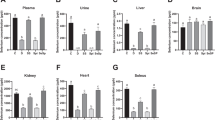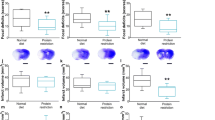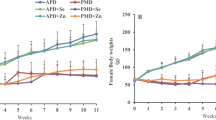Abstract
The effect of ad libitum ingestion of selenium (Se) in drinking water (0.15 mg SeO2/L) for 3 wk on the brain weight, total brain protein, glutathione (GSH) level, catalase activity, and lipid peroxidation in the brain of protein-undernourished (PU) rats was investigated, in an attempt to determine whether antioxidants alone can reverse some of the neuropathological changes associated with protein undernutrition in rats. Feeding on a normal diet (16% casein) by well-fed rats or a low-protein diet (5% casein) by PU rats and Se-treated PU rats lasted 14 wk. Setreated PU rats were given Se in drinking water during the last 3 wk of the experiment. Results show that protein undernutrition induced significant reductions (p<0.001) in brain weight, total brain protein, and catalase activity (p<0.05) while it induced a significant increase (p<0.05) in lipid peroxidation when compared with well-nourished rats; but no significant effect was observed for the GSH level. However, the ingestion of Se in drinking water by PU rats for 3 wk resulted in significant increases (p<0.05) in brain weight, catalase activity, and total brain protein but induced a significant reduction (p<0.05) in lipid peroxidation when compared with PU rats given water. The values obtained for Setreated PU rats are comparable with those obtained for well-nourished rats. The GSH level was, however, not affected by Se ingestion. We suggest that Se, by inducing increases in the concentration of certain proteins, including catalase, in the brain, abolished some of the pathological changes associated with protein undermutrition in the brain, and appears as a promising antioxidant in the prevention and management of pro-oxidant-induced brain damage.
Similar content being viewed by others
References
M. S. Rukmini, B. D'Souza, and V. D'Souza, Superoxide dismutase and catalase activities and their correlation with malondialhehyde in schizophrenic patients, Indian J. Clin. Biochem. 19, 114–118 (2004).
L. T. McGrath, B. M. McGleenon, B. Brennan, D. McColl, S. MclLroy, and A. P. Passmore, Increased oxidative stress in Alzheimer's disease as assessed with 4-hydroxynonenal but not malondialdehyde. Q. J. Med. 94, 485–490 (2001).
A. Castegna, M. Aksenov, V. Thongboonkerd, et al., Proteomic identification of oxidatively modified proteins in Alzheimer's disease brain, Naff Symposium Posters, No. 9 2003.
M. A. Levy, B. Sikorski, and T. M. Bray, Selective elevation of glutathione levels in target tissues with l-2-oxothiazolidine-4-carboxylate (OTC) protects against hyperoxia induced lung damage in protein-energy malnourished rats: implications for a new treatment strategy, J. Nutr. 128, 671–676 (1998).
G. A. Adenuga, The Ca2+-transporting activity of rat liver microsomes in response to protein-undernutrition: implications for liver tumor promotion, Biosci. Rep. 20, 93–98 (2001).
D. A. Levitsky and B. J. Strupp, Malnutrition and the brain: changing concepts, changing concerns, J. Nutr. 125, 22, 12S-22, 20S (1995).
H. Lenhartz, R. Ndasi, A. Anninos, et al., The clinical manifestation of Kwashiorkor Syndrome is related to increased lipid peroxidation, J. Pediatr. 132, 879–881 (1998).
T. M. Bray and C. G. Taylor, Enhancement of tissue glutathione for antioxidant and immune function in malnutrition, Biochem. Pharmacol. 47, 2113–2123 (1994).
J. O. Olowookere, Bioenergetics of Kwashiorkor and Obesity, Triumph Books, Ijebu-Ode, Nigeria, pp. 139–143 (1994).
K. J. Wedekind, S. Yu, and G. F. Combs, The selenium requirement of the puppy, J. Anim. Physiol. Anim. Nutr. (Berl). 88, 340–347 (2004).
R. Varshney and R. F. Kale, Effect of calmodulin antagogists on radiation induced lipid peroxidation in microsomes, Int. J. Radial. Biol. 58, 733–743 (1990).
O. H. Lowry, N. J. Rosebrough, A. L. Farr, and N. J. Randall, Protein measurement with folin phenol reagent, J. Biol. Chem. 193, 265–275 (1951).
E. Beutler, D. Duron, and B. M. Kelly, Improved method for the determination of blood glutathione, J. Lab. Clin. Med. 61, 882–888 (1963).
K. A. Sinha, Colorimetric assay of catalase, Anal. Biochem. 47, 389–394 (1972).
P. J. Morgane, R. Austin-La France, J. Bronzino, et al., Prenatal malnutrition and developmental of the brain, Neurosci. Biobehav. Rev. 17, 91–128 (1993).
C. Sarkar, S. Roy, and G. Gopinath, Effects of neonatal undernutrition on the brain, Proc. Indian Natl. Sci. Acad. B: Biol. Sci. 56, 29–36 (1990).
M. Rayman, The importance of selenium to human health, Lancet 356, 9225 (2000).
M. A. Levy and T. M. Bray, The antioxidant function of dietary zinc and protection against neural disorders, Linus pauling Institute Research Reports (2003).
C. Behl and B. Moosmann, Antioxidant neuroprotection in Alzheimer's disease as preventive and therapeutic approach, Free Radical Biol. Med. 33, 182–191 (2002).
M. P. Mattson, W. Duan, W. A. Pedersen, and C. Culmsee, Neurodegenerative disorders and Ischemic brain diseases, Apoptosis 6, 69–81 (2001).
L. M. Ambani, M. H. Van Woert, and S. Murphy, Brain peroxidase and Parkinson disease, Arch Neurol. 32, 114 (1975).
M. Y. Aksenov, H. M. Tucker, P. Nair, et al., The expression of key oxidative stress-handling genes in different brain regions in Alzheimer's disease, J. Mol. Neurosci. 11, 151–164 (1998).
K. Batcioglu, A. A. Karagozler, I. C. Ozturk, et al., Comparison of chemopreventive effects of vitamin E plus selenium versus melatonin in 7,12-dimethylbenz(a)anthracene-induced mouse brain damage, Cancer Detect. Prev. 29, 54–58 (2005).
S. Chakrabati and R. Shankar, Lipid peroxidation in developing rat brain during undernutrition, Neurosci. Lett. 48, 109–113 (1984).
E. J. Sambuichi, A. Lai, Y. Kido, F. Shizuka, and K. Kishi, Protein deficiency and excess lipid synergistically augmented lipid peroxidation in growing rats, Tokushima J. Exp. Med. 39, 81–87 (1992).
Author information
Authors and Affiliations
Rights and permissions
About this article
Cite this article
Adebayo, O.L., Adenuga, G.A. Protective effect of selenium on protein-undernutrition-induced brain damage in rats. Biol Trace Elem Res 116, 227–234 (2007). https://doi.org/10.1007/BF02685933
Received:
Revised:
Accepted:
Issue Date:
DOI: https://doi.org/10.1007/BF02685933




